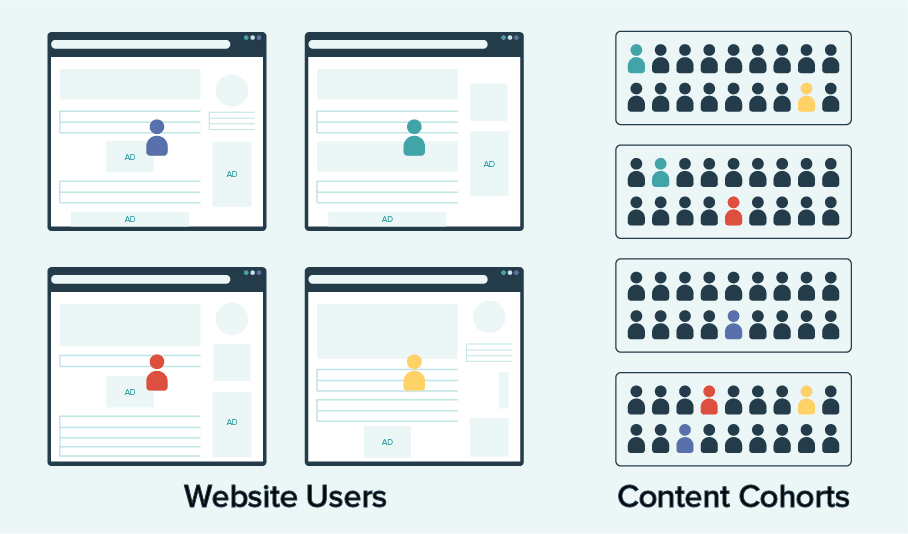Privacy Sandbox: FLoC Testing to Begin Soon!


As you’ve heard us talk about at length, Chrome is joining the ranks of Firefox, Safari and others by phasing out third-party cookies by 2022, forever changing programmatic advertising in the process.
Replacing third-party cookies will require a twofold solution comprised of first-party data and what Google calls the Privacy Sandbox.
Today, we’re focusing on the latter.
The Privacy Sandbox is a proposed collection of web browser features that, when combined, aim to replace many of the previous uses of third-party cookies in advertising.
One such Sandbox initiative, FLoC – which Google has announced, along with its launch date and early test data – is the subject of this post.
FLoC is a Privacy Sandbox solution designed to provide targeted programmatic advertising based on the interests of the user browsing a page but in a privacy-centric way.
It stands for Federated Learning of Cohorts, which is Google’s attempt to shoehorn every component of the Privacy Sandbox into an overarching bird or avian theme for reasons unknown.
Anyway, the concept of FLoC is that when a user browses websites, that user is assigned to a cohort, or a group of users, with similar interests.
For example, if you visit sites about cars and technology, you’ll likely be assigned to a cohort or group of people who also visit similar sites.

That cohort is your flock. See what they did there? Birds of a feather and all that. The FLoC name makes so much sense.
Google will be using machine learning, or artificial intelligence, inside the web browser to learn and place you into these cohorts.
Both internet users and websites themselves are opted in by default to the cohorting process, although there are means of opting out.
FLoC might sound like another mysterious black box, not unlike the third party-cookies it’s replacing, but that’s the cool part.
Living up to its billing as a privacy-first solution, FLoC ensures that cohorts are named by anonymous ID (e.g. 43A7) — not necessarily “people looking to buy a house” or a “family expecting a baby” — and that enough users are assigned to each cohort to keep individuals anonymous.
Beyond that, Google is proposing a degree of randomness to ensure that even if two users browse the exact combination of sites (impossible, but let’s pretend), they can still end up in separate cohorts.
Additionally, Google will be doing its best to guarantee that Sensitive Categories are excluded from FLoC to keep user identities safe.
We know what you’re thinking. Keeping identities private is great, but how can targeting possibly work when you do?
Good question — and we have a slightly complicated answer for you.
This is where the FLoC / cohort system is going to require significant investment by DSPs (Demand Side Platforms), the software that advertisers are using to buy ads programmatically.
Like Google, DSPs will also have to use machine learning in order to learn the audiences these cohorts correspond to, determine the cohorts which convert best for each campaign and then properly target them.
It’s advanced, but the good news is that Google has already tested this concept with its own ad-buying software, Google Ads.
On its own DSP, Google found that FLoC was very effective — up to 95% as effective as third-party cookies in terms of targeting and conversions.
Given the initial estimates of revenue declines of 60% in a world without third-party cookies, a 5% decline is pretty impressive.
It’s important to note this was only a limited test, and it will be a long road to widespread implementation but it’s encouraging.
Absolutely. As the most award-winning Google Certified Publishing Partner, you can guarantee we’ll be working closely with Google on any new ad initiatives, including FLoC and the rest of the Privacy Sandbox.
Google is expected to begin making FLoC available to the public in March, and we’ll begin implementation on the Mediavine side as soon as we’re able.
As for Google’s DSP itself, cohorts are expected to hatch, er, sorry, become available in Google Ad products in Q2.

Unfortunately, no. As we said above, first-party data and the Privacy Sandbox present a two-pronged approach to this challenge.
For all its capabilities, FLoC is a fairly limited proposal that can’t fully meet the needs of the programmatic advertising world.
FLoC cohorts are still controlled by the browser and are therefore limited. They may work better for certain advertiser needs than for others.
For example, cohorts won’t solve for retargeting (e.g. an ad you show to someone who recently put a pair of shoes in their shopping cart).
Beyond that, FLoC in its current form is only being tested by Chrome. Until Safari, Firefox, Edge and other browsers support it, this isn’t a fully viable, scalable third-party cookie replacement.
Don’t take our word for it: Google’s FLoC proposal says it’s meant to help supplement first-party data, contextual and — wait for it — FLEDGE / TURTLEDOVE (two Sandbox birds we’ll discuss in future posts).
We’re excited to implement FLoC and for its potential to help mitigate revenue losses originally estimated to be much greater.
But again it’s a small part of a bigger plan.
Think of it this way: As a publisher, when it comes to the future of the cookie-less web, would you rather lose 5% of your revenue or make 30-60% more?
That’s where Grow and first-party data come in.
Thanks to the value exchange provided through Grow, publishers can incentivize readers to log in, consent to personalized ads (and content recommendations) and potentially earn more ad revenue per user right now.
This, plus the tools provided by the Privacy Sandbox geared towards non-logged-in users, are all part of the path forward this year and beyond.
Getting there will take time — and experimentation — but we believe the end result will be a more sustainable, free and open web.
Mediavine is excited to help reinvent an evolving ecosystem that works for publishers, advertisers and readers alike.
In a few years, we’ll all look back on this and realize third-party cookies were for the birds all along.
(Sorry.)
Stay up to date with the latest from Mediavine
As the digital advertising landscape evolves, the need for effective data management and compliance has never been more critical. As part of our commitment to providing exceptional solutions for our …
Welcome to the much-anticipated release of the fifth-annual edition of “The Best eCPM Days of the Year” calendar. Each year, we analyze historical trends to provide publishers with a graphical …
“Let’s talk about politics.” We know. This is a phrase absolutely no one wants to hear uttered around the dinner table or backyard barbecue these days. But hear us out. …